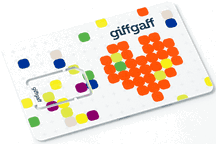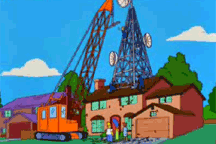Sunday 30 May, 2010, 14:23 - Much Ado About Nothing
 Travelling on the London Underground last week, Wireless Waffle was intrigued by an advertisement for GiffGaff which marketed itself as 'the mobile network run by you'. Visions of self installed cell sites connected back to the network infrastructure by home (or business) broadband connections flashed in front of the eyes. Notions of a new style of organic mobile network where coverage is provided by the users themselves caused a twitch of our technology antennae.
Travelling on the London Underground last week, Wireless Waffle was intrigued by an advertisement for GiffGaff which marketed itself as 'the mobile network run by you'. Visions of self installed cell sites connected back to the network infrastructure by home (or business) broadband connections flashed in front of the eyes. Notions of a new style of organic mobile network where coverage is provided by the users themselves caused a twitch of our technology antennae. Sadly, upon visiting the GiffGaff web-site it turns out to be yet another Mobile Virtual Network Operator (MVNO) like Virgin Mobile, Tesco Mobile and others - and in this case, one which uses O2's mobile network. The 'network run by you' is simply an incentive to get you to get your friends to use GiffGaff SIM cards, a marketing ploy and not a new kind of network at all.
But would it be possible to construct a 'network truly run by you'? Believe it or not, the technology to do this already exists:
Firstly, there are phone handsets which use a WiFi connection to connect to the Internet and then using a suitable service provider, act as extended range cordless phones. They are extended in that if you take them with you to another place where there is a suitable WiFi connection, they log back on to the network and enable you to make and receive calls. Unlike a true mobile service, however, there is no hand-over between WiFi connections meaning that if you move in or out of coverage the call you are making will drop out. But with a WiFi phone you can sit in a coffee shop and make and receive calls as if you were at home - whether or not there is really any value in doing this when you could use an everyday mobile phone is a moot point.
In Japan and some other Asian countries, there is a mobile phone technology known as the Personal Handyphone System (PHS for short) which is technologically similar to the DECT digital cordless phones used in Europe. PHS (and it's 3G variant known as XGP) use short range, cordless phone like base stations which connect back to a central newtork control centre via a standard telecommunications connection (historically an ISDN circuit). The resulting network is similar to that of WiFi phones in that you have a home cordless phone, but which you can take with you to other houses where coverage exists (eg other PHS subscribers). The main difference between PHS and WiFi phones is that there is proper hand-over between cells such that you can walk down a street where there is PHS coverage and continue to make your call. Indeed, by adding a few cell sites at key locations and relying on users to extend coverage by their home connections, reasonably large coverage has been achieved without the operator needing to put expensive cell sites everywhere. One of the main problems of PHS is that cell sizes are relatively small due to the low power nature of the technology, but no smaller than that of a WiFi connection. It is now also rather antiquated technology and it is not clear whether operators will upgrade to XGP or some other technology - PHS subscriber numbers are on the decline.
 More recently there has been a development typified by services such as Vodafone's Sure Signal. These are miniature cell sites known as 'femto cells' which plug into your broadband connection and provide (in this case) 3G coverage in the immediate area. Having a 3G cell site in your house (or office) gets around the problem of coverage blackspots in a big way. Femto cells are fully working parts of the mobile network to which they are connected and therefore you can seamlessly roam in and out of coverage as you leave home (as indeed you can with PHS). 3G femto cells allow you to use your 3G phone or data card at home and in nearby areas.
More recently there has been a development typified by services such as Vodafone's Sure Signal. These are miniature cell sites known as 'femto cells' which plug into your broadband connection and provide (in this case) 3G coverage in the immediate area. Having a 3G cell site in your house (or office) gets around the problem of coverage blackspots in a big way. Femto cells are fully working parts of the mobile network to which they are connected and therefore you can seamlessly roam in and out of coverage as you leave home (as indeed you can with PHS). 3G femto cells allow you to use your 3G phone or data card at home and in nearby areas.Now... imagine a situation where a whole street had installed femto cells such that there was unbroken coverage as you walked or drove along it. There would be no need for coverage provided by any official network operator. In this case all the network coverage would be provided by the users. All that would be required would be some organisation to provide the central functions such as allocating phone numbers and managing mobility (handing over calls between cells) and hey presto! - truly a 'network run by you'. The only thing stopping anyone from launching such a service is lack of (harmonised) radio spectrum. In theory, someone could launch a 'network run by you' in the same, unlicensed spectrum, used by WiFi devices but the handsets they would need would be proprietary and thus expensive. If they could roll-out 3G femto cells instead, the handsets would be available off the shelf. But all of the 3G frequencies have already been assigned to licensed operators who are, in no way, going to allow some upstart to usurp some of their valuable spectrum.
 Which is kind of where organisations such as Google and Microsoft step up to the lectern with their desire to operate 'WiFi 2.0' in spectrum known as whitespace. Whitespace spectrum is that which lives inbetween terrestrial television transmitters but which cannot be used for more television without causing interferenece. It could be used for lower power short-range services though - such as femto cells for example. So combine the idea of femto cells, widely available, licence-free spectrum with big money backers, and perhaps the concept of a network 'run by you' is closer than might have first been apparent.
Which is kind of where organisations such as Google and Microsoft step up to the lectern with their desire to operate 'WiFi 2.0' in spectrum known as whitespace. Whitespace spectrum is that which lives inbetween terrestrial television transmitters but which cannot be used for more television without causing interferenece. It could be used for lower power short-range services though - such as femto cells for example. So combine the idea of femto cells, widely available, licence-free spectrum with big money backers, and perhaps the concept of a network 'run by you' is closer than might have first been apparent.Julian G4ILO
Tuesday 8 June, 2010, 14:30
All very well in theory, but isn't the problem in practise that everyone has been persuaded to encrypt their wi-fi connections now?Wednesday 11 August, 2010, 15:14
"All that would be required would be some organisation to provide the central functions such as allocating phone numbers and managing mobility (handing over calls between cells) and hey presto!"ie: a network operator! Without that your femto would be as useful as an ashtray on a motorbike!
Yes I do work for a network operator!
